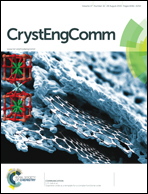Ion template effects of 4,5-dicyanoimidazole in the assembly of a series of 3D bimetallic coordination networks†
Abstract
Nine 3D isomorphic bimetallic coordination polymers with different alkali metals (Na, K, and Rb) and halides (Cl, Br, and I) have demonstrated that the 4,5-dicyanoimidazole ligand is a good template in the assembly of bimetallic–organic networks. This provides an excellent template for the investigation of ion exchange and single-crystal to single-crystal (SCSC) transformation. The series of coordination polymers shows an unprecedented (3,4,6)-connected (5·72)6(52·6·73)6(56·66·73) net with a high topology density.


 Please wait while we load your content...
Please wait while we load your content...